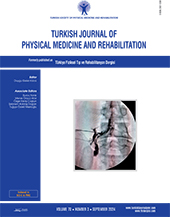Short-term effectiveness of epidermis dermis fascia kinesiotaping technique in myofascial pain syndrome on upper trapezius: A multi-center, double-blind, randomized clinical study
2 Department of Physical Medicine and Rehabilitation, Istanbul Aydın University, Istanbul, Türkiye
3 Department of Physical Medicine and Rehabilitation, University of Health Sciences, Bakırköy Sadi Konuk Training and Research Hospital, Istanbul, Türkiye
4 Department of Physical Medicine and Rehabilitation, Istanbul Medeniyet University, School of Medicine, Istanbul, Türkiye
5 Department of Physical Medicine and Rehabilitation, Ankara University, School of Medicine, Ankara, Türkiye
6 Department of Physical Medicine and Rehabilitation, Atılım University, School of Medicine, Ankara, Türkiye
7 Department of Physical Medicine and Rehabilitation, University of Health Sciences, Samatya Education and Research Hospital, Istanbul, Türkiye
8 Department of Physical Medicine and Rehabilitation, Kırklareli Training and Research Hospital, Kırklareli, Türkiye
9 Department of Physical Medicine and Rehabilitation, Ankara Etlik City Hospital, Ankara, Türkiye
10 Istanbul Topkapı University, Faculty of Sports Science, Istanbul, Türkiye
11 Department of Biostatistics, Yeditepe University Faculty of Medicine, Istanbul, Türkiye DOI : 10.5606/tftrd.2024.14151 Objectives: This study aims to investigate the efficacy of epidermis dermis fascia (EDF) kinesiotaping (KT) technique on pain intensity, number of active trigger points (TrPs), cervical range of motion (ROM) angles, and disability levels in patients with myofascial pain syndrome (MPS) on upper trapezius (UT) muscle.
Patients and methods: Between January 2019 and January 2020, a total of 180 patients (21 males, 159 females; mean age: 35.9±9.0 years; range, 18 to 56 years) with MPS were included. The patients were randomized into either KT with EDF technique (Group 1) or sham KT (Group 2). Outcome measures were Visual Analog Scale (VAS) pain score, number of active TrPs, cervical ROM angles, and Neck Pain Disability Scale (NPDS).
Results: Both groups improved in terms of all outcome parameters except for cervical flexion and extension angles in Group 2. The VAS pain scores significantly decreased in Group 1 (p<0.05), compared to Group 2. The number of active TrPs (p=0.001) and NPDS scores (p=0.016) of Group 1 significantly improved than Group 2. Cervical flexion (p=0.001), extension (p=0.001), and left and right lateral flexion angles (p<0.0001) significantly improved in Group 1. Cervical left (p=0.001) and right (p<0.0001) lateral flexion angles significantly improved in Group 2. There was no significant difference between the groups regarding cervical ROM angles.
Conclusion: Our study results suggest that KT with the EDF technique is an effective method in reducing pain and number of active TrPs, improving disability and cervical ROM angles.
Keywords : Kinesiotaping, myofascial pain syndrome, trigger point

















